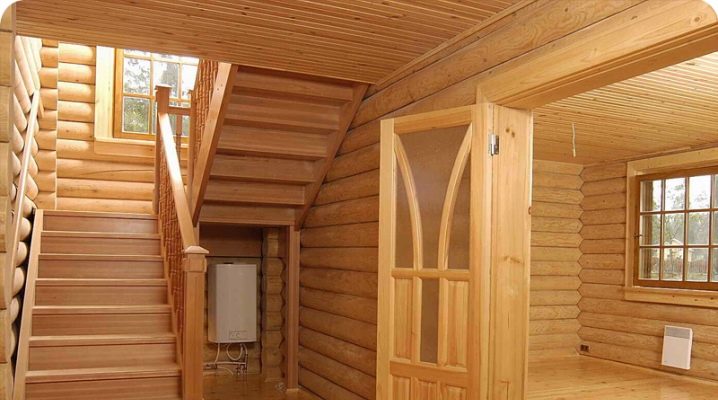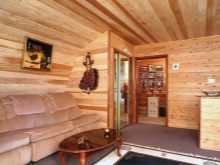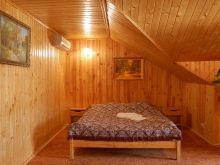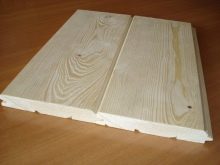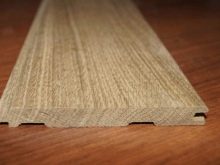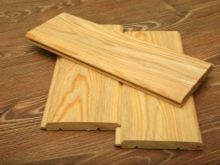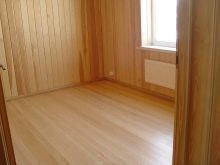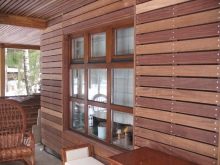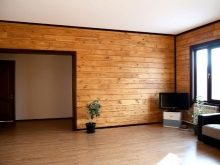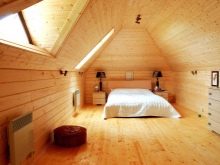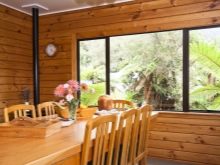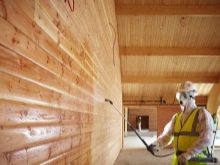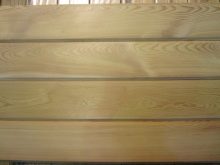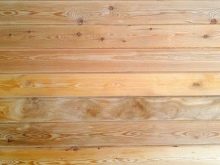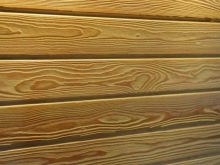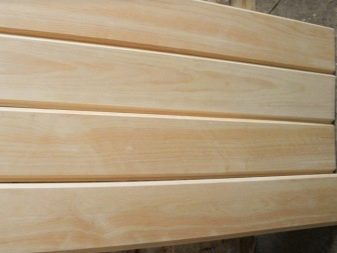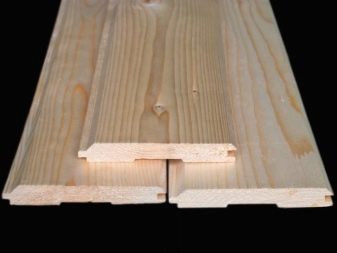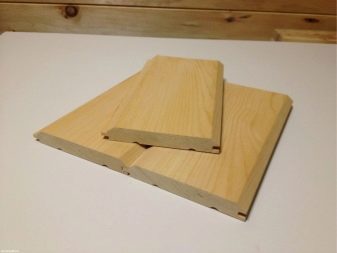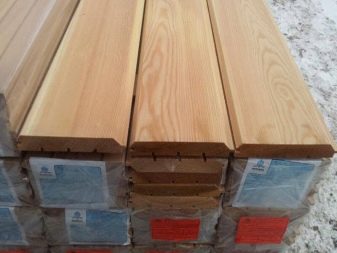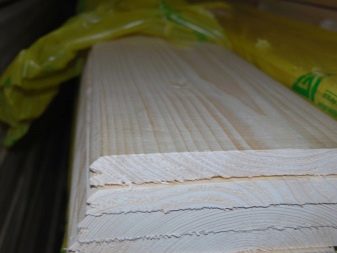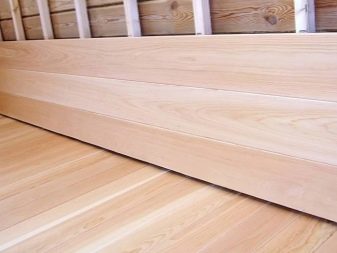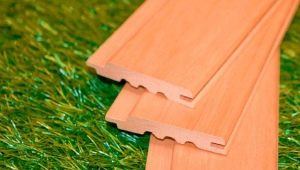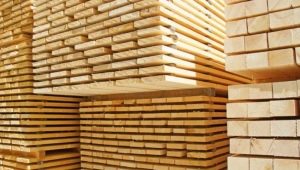Lining with imitation of timber: advantages and disadvantages
Wood is one of the most popular building and finishing materials. However, not everyone can afford to build a house of natural expensive timber. As an alternative, you can use lining under the timber for wall decoration. This material does not hit hard on the budget and will look no less aesthetic. The advantages and disadvantages of lining with imitation timber can be considered in more detail in this article.
Special features
Lining is a board of small thickness, which are used for interior and exterior decoration. The panels are interconnected with spikes and grooves.
Material with imitation of timber differs from other types of lining in the following parameters:
- The thickness of the panels under the timber is larger than that of the classic lining (up to 1.6 cm) and can be from 1.6 to 3.7 cm. Thanks to these parameters, the finish is visually similar to a natural wooden beam.
- For high-quality imitation of timber the width of the panels is at least 11 centimeters.
- Installation of the material under the timber can be made only in the horizontal plane, while as a regular clapboard you can still attach vertically and diagonally.
- Boards with imitation of timber have special slots on the side, which is necessary for ventilation.
- The surface of the wall upholstered under the timber is more prominent.
Scope of application
This material is used for exterior and interior decoration of private houses or baths. Sheathing clapboard under the timber can not only walls, but also ceilings. The base material is not important, the main thing is that there are no strong irregularities on the surface.
Panels with imitation timber not only ennobles the appearance of the room, but also create a favorable microclimateas made of eco-friendly materials. To finish the walls inside the room, it is best to use wide panels (130–150 millimeters), which will visually increase the area of a small room.
Thicker and wider (200 millimeters) boards are used for exterior decoration, which allows creating the effect of a house from a natural bar.Before proceeding with the installation, you need to take care of sound and heat insulation.
Advantages and disadvantages
As well as all finishing materials, lining under a bar has its advantages and disadvantages.
Consider the main advantages of such panels:
- Aesthetic appearance. The material will perfectly fit into almost any interior design room.
- Resistance to deformation. The panels are made of durable and resistant to mechanical stress materials.
- High resistance to decay. Larch plank boards can even be used in rooms with high humidity levels.
- Environmental friendliness. The panels are made only from natural wood of good quality.
- Low cost in comparison with a natural bar.
- Suitable for walls and ceilings of almost any type.
- Ease of installation.
- Long service life, which is about 25 years, if the panels are not treated with additional funds from microorganisms and mold. Processing boards with special compositions will only increase their service life.
- Provides sound and heat insulation. However, you should not use such panels as the main insulating material.
Despite significant advantages, the material has several disadvantages. For the most part, the disadvantages are due to the characteristics of the wood that was used for the manufacture of lining.
The main disadvantages of the panels under the timber include the following:
- Some types of wood from which lining is made are not classified as fireproof materials. Such products must be treated with special compositions.
- The choice of material for the exterior should be approached with special care. Wood must be resistant to precipitation and not fade from direct sunlight.
- Not all the wood from which the lining under the timber is made is distinguished by good resistance to rotting and fungal formations. For this reason, it is recommended to annually treat the material with special formulations with an antiseptic.
Kinds
Lining the timber has many varieties that differ not only in size but also in quality. Quality primarily depends on the material that was used for the manufacture of panels.
Lining the timber is divided into three main classes:
- “A” - this class includes boards of the highest quality. There are no defects on the surface of such panels.
- "B" - on the surface of the panel in this group there are minor defects. In appearance, these materials are inferior to the panels of class "A", but they are much lower.
- "C" - the most budget version of the panels under the timber. The material is not the best quality, on the surface of which there are defects. Often these panels need additional grinding.
Material
Its cost and some characteristics will depend on the material that was used for the manufacture of the wall paneling.
For the production of such panels most often use the following types of wood:
- Pine;
- spruce;
- cedar;
- larch.
Pine and spruce have a high level of resistance to decay. In addition, this wood has a wonderful resinous smell. Compared to pine, spruce is not as strong and resistant to external negative factors.
Cedar can be called both durable and soft material. This wood has antiseptic properties and cleans the air from bacteria. Cedar lining has a light shade and a beautiful texture.Since the material belongs to coniferous trees and contains a lot of resin, it has good resistance to putrefactive processes.
Panels and larches are great not only for finishing the house, but also for baths. Such wood is considered a fireproof material: the panels do not heat up due to high temperatures and cannot be burned about them.
Larch is also resistant to increased moisture levels, so it does not swell, is not subject to deformation and rotting. Another significant advantage of this material is high strength.
The size
As it was already noted earlier, panels under a bar have more impressive sizes, than classical lining. The length of the board can reach six meters. The width of such products varies from 6.5 to 20 centimeters. In the construction market you can also find products with a width of 25 centimeters, but since the demand for such panels is small and the price is quite high, you can rarely meet them.
As for the thickness of the panels, the most common options range from 1.8 to 3.4 centimeters. The thickness and quality of the finish depends on the thickness. Some companies can make custom-made clapboard byindividual parameters.
Recommendations for selection
When choosing, first of all you need to focus on the type of finish. If the panels will be used for the facade of the building, then special attention should be paid to the quality of wood and size. The material must be resistant to the negative effects of the environment. With regard to the parameters of the boards, then for the exterior trim better fit wider and thicker panels.
For interior decoration, you can use less expensive and thin wall paneling. In this case, the main criterion when choosing a material is not its resistance to external influences, but an aesthetic appearance. The only exceptions are rooms with high humidity levels.
Installation tips are in the next video.
